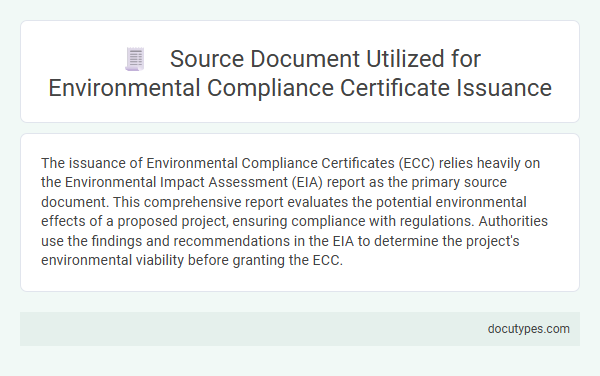The issuance of Environmental Compliance Certificates (ECC) relies heavily on the Environmental Impact Assessment (EIA) report as the primary source document. This comprehensive report evaluates the potential environmental effects of a proposed project, ensuring compliance with regulations. Authorities use the findings and recommendations in the EIA to determine the project's environmental viability before granting the ECC.
Introduction to Environmental Compliance Certificates
What source document is used in the issuance of Environmental Compliance Certificates? Environmental Compliance Certificates (ECC) serve as proof that a project complies with environmental regulations and standards. The primary source document for issuing an ECC is the Environmental Impact Assessment (EIA) report.
Definition and Importance of Source Documents
Source documents are original records that provide the necessary evidence for issuing Environmental Compliance Certificates (ECC). These documents include project proposals, environmental impact assessments, and regulatory permits.
Source documents validate that an activity or project complies with environmental laws and regulations. Your reliance on accurate source documents ensures the legitimacy and credibility of the ECC issuance process.
Types of Source Documents Required
Source documents used in the issuance of Environmental Compliance Certificates (ECC) include environmental impact assessments, project descriptions, and proof of public consultations. These documents provide detailed information on the potential environmental effects of a project and its compliance with legal standards. Regulatory agencies require these types of documents to ensure thorough evaluation before granting the ECC.
Legal Framework Governing Source Document Submission
The source document used in the issuance of Environmental Compliance Certificates (ECCs) primarily includes the Environmental Impact Assessment (EIA) report, which details the anticipated environmental effects of a proposed project. This report is prepared in accordance with guidelines set by the Department of Environment and Natural Resources (DENR) under the Environmental Impact Statement (EIS) System.
The legal framework governing the submission of source documents mandates compliance with the Presidential Decree No. 1586. This decree requires project proponents to submit an EIA report for review before ECC issuance. You must ensure that all documentation aligns with DENR standards to facilitate the approval process.
Document Verification and Validation Procedures
| Source Document for Environmental Compliance Certificate Issuance | Environmental Impact Assessment (EIA) Report |
|---|---|
| Purpose of the Source Document | Provides detailed analysis of environmental risks and mitigation strategies for proposed projects |
| Verification Procedures |
|
| Validation Procedures |
|
| Outcome of Document Verification and Validation | Ensures issuance of Environmental Compliance Certificate only to projects meeting environmental performance standards |
Commonly Accepted Source Documents for Compliance
Source documents play a crucial role in the issuance of Environmental Compliance Certificates (ECC). These documents provide verified information that ensures compliance with environmental regulations and standards.
- Environmental Impact Assessment (EIA) Report - A comprehensive analysis detailing the potential environmental effects of a proposed project.
- Project Description - A detailed outline of the project's scope, design, and operational procedures submitted for environmental review.
- Environmental Management Plan (EMP) - A strategic plan outlining mitigation measures and monitoring programs to minimize environmental impact.
These commonly accepted source documents are essential for validating compliance and securing the Environmental Compliance Certificate.
Role of Source Documents in Environmental Assessment
Source documents play a critical role in the issuance of Environmental Compliance Certificates by providing verified data used in environmental assessments. These documents serve as the foundation for evaluating the potential impact of a project on the environment.
- Environmental Impact Assessment Reports - Detailed analyses that inform the decision-making process regarding environmental compliance.
- Baseline Environmental Data - Initial site conditions data essential for comparing pre- and post-project environmental status.
- Regulatory Permits and Approvals - Official authorizations that validate adherence to environmental laws and standards.
Challenges in Source Document Collection
Source documents essential for issuing Environmental Compliance Certificates (ECC) include Environmental Impact Assessments (EIA), project plans, and government approvals. These documents verify adherence to environmental laws and standards required by regulatory agencies.
Challenges in collecting these source documents often involve incomplete or inconsistent data from project proponents and delays in obtaining necessary government permits. Ensuring the accuracy and authenticity of documents significantly impacts the timely issuance of Environmental Compliance Certificates.
Best Practices for Managing Source Documents
The source document used in the issuance of Environmental Compliance Certificates (ECC) is the Environmental Impact Assessment (EIA) report, which details potential environmental effects and proposed mitigation measures. Best practices for managing source documents include maintaining accurate, up-to-date digital records with proper version control to ensure traceability and compliance. You should implement secure storage solutions and systematic documentation review to facilitate efficient audits and regulatory inspections.
What Source Document Is Used in the Issuance of Environmental Compliance Certificates? Infographic

